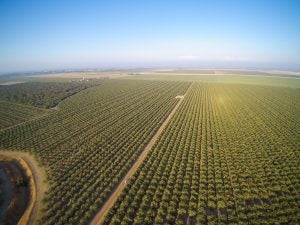Almonds are having their moment right now. Between the hotly debated almond milk and almond butter or flour products, there is a lot of buzz around this food. It is deserving of the attention, as the commodity is a power house when it comes to health benefits.
They are almost exclusive to California, since the state is the only commercial producer in North America (and the United States is the top producer in the world). With the ever-changing preferences of consumers to be less wasteful, and so many almonds being grown, is there any waste that these tree nuts create?
Almonds are technically a stone fruit (closely related to peaches and nectarines), which means that the “almond” is the kernel inside of a shell inside of a hull. So, when you’re eating an almond, it’s been removed from two other layers prior. During the shelling process extra pieces of the almond may fall off as well and will be discarded. This is referred to as “hash.” These aforementioned layers and bits of almonds could be considered waste in the food world. However, with research from the USDA’s Western Regional Research Center, the shells and hulls, and even entire trees are being put to a greater use as byproducts.
The Western Regional Research Center in California has been researching alternative uses for almond c0-products for many years, and what the industry has been able to do with this fruit is an amazing display of the agriculture industry’s commitment to ending food waste.

Most of an almond’s byproducts are used for other sectors of agriculture. In the poultry and dairy industries, almond hulls (the green outermost layer) are a huge source of feedstuffs due to their high nutrient content and ability to keep feed costs down for producers. Did you know, though, that research is being done to feed hulls to black soldier fly larvae? These insects can then be fed to poultry and fish that are being farmed for human consumption. A few reasons why this is being researched is because the insect is attracted to this clean source of feed and using this feedstock is geographically more advantageous to California as well as more efficient when it comes to producing insect protein versus soy protein. A presentation was done on this topic during the 2018 Almond Conference and dives a bit more into the scientific side of things.
Shells and hash are implemented in other ways. Shells are what protect the almond kernel, and hash, as mentioned before, is remnants of the fruit that have fallen off during shelling. If you’re looking for garden bedding or landscape materials, shells might be your go-to; they also happen to be used as livestock bedding. Hash can be used for higher-end animal feed, according to one of California’s most beloved almond advocates, Almond Girl Jenny.
There are many other ways the co-products of an almond kernel are used, like grinding up old almond trees and shells to use for “co-generation” plants to produce electricity. A new approach being encouraged by the Almond Board is Whole Orchard Recycling. This just means that the remnants of the old trees are tilled back into the soil where new trees will be planted to improve soil health. Other possible items that can be replaced with almond co-products, like food grade sugars, plastics, and even baby diaper absorbent, are also being researched by The Almond Board of California. It’s important to note that a lot of research is still needing to be done in order to understand the full effects of co-product use, but the industry is hopeful and studies haven’t disappointed yet.
Technology, the environment, consumer preferences, and market prices are just some of the reasons behind the need to limit food waste and find more value in the products being grown. While almond products are trending right now, it’s apparent that the industry is working hard to make them a staple in our lives and it appears they aren’t losing momentum any time soon.
Markie Hageman majored in agribusiness at Fort Hays State University. She is actively involved in her state Cattlemen’s Association, Young Farmers chapter, and National Cattlemen’s Beef Association. Her AGDAILY.com articles can be found here.



